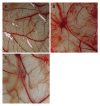Antisense oligonucleotide targeting midkine suppresses in vivo angiogenesis
- PMID: 17451201
- PMCID: PMC4146995
- DOI: 10.3748/wjg.v13.i8.1208
Antisense oligonucleotide targeting midkine suppresses in vivo angiogenesis
Abstract
Aim: To evaluate the effect of antisense oligonucleotide targeting midkine (MK-AS) on angiogenesis in chick chorioallantoic membrane (CAM) and in situ human hepatocellular carcinoma (HCC).
Methods: An in situ human hepatocellular carcinoma (HCC) model and CAM assay were used in this experiment. The effect of MK-AS on angiogenesis was evaluated by cell proliferation assay and hematoxylin-eosin (HE) staining.
Results: MK-AS significantly inhibited human umbilical vein endothelial cells (HUVEC) and in situ human HCC growth. At the same time, MK-AS suppressed the angiogenesis both in human hepatocellular carcinoma cell line (HEPG2)-induced CAM and in situ human HCC tissues.
Conclusion: MK-AS is an effective antiangiogenesis agent in vivo.
Figures





Similar articles
-
Midkine translocated to nucleoli and involved in carcinogenesis.World J Gastroenterol. 2009 Jan 28;15(4):412-6. doi: 10.3748/wjg.15.412. World J Gastroenterol. 2009. PMID: 19152444 Free PMC article. Review.
-
Enhanced therapeutic effects of combined chemotherapeutic drugs and midkine antisense oligonucleotides for hepatocellular carcinoma.World J Gastroenterol. 2007 Apr 7;13(13):1989-94. doi: 10.3748/wjg.v13.i13.1989. World J Gastroenterol. 2007. PMID: 17461503 Free PMC article.
-
Antisense oligonucleotides targeting midkine induced apoptosis and increased chemosensitivity in hepatocellular carcinoma cells.Acta Pharmacol Sin. 2006 Dec;27(12):1630-6. doi: 10.1111/j.1745-7254.2006.00459.x. Acta Pharmacol Sin. 2006. Retraction in: Acta Pharmacol Sin. 2019 Nov;40(11):1501. doi: 10.1038/s41401-019-0235-7. PMID: 17112419 Retracted.
-
Antisense oligonucleotides targeting midkine inhibit tumor growth in an in situ human hepatocellular carcinoma model.Acta Pharmacol Sin. 2007 Mar;28(3):453-8. doi: 10.1111/j.1745-7254.2007.00532.x. Acta Pharmacol Sin. 2007. Retraction in: Acta Pharmacol Sin. 2019 Nov;40(11):1502. doi: 10.1038/s41401-019-0236-6. PMID: 17303011 Retracted.
-
Midkine: a promising molecule for drug development to treat diseases of the central nervous system.Curr Pharm Des. 2011;17(5):410-23. doi: 10.2174/138161211795164167. Curr Pharm Des. 2011. PMID: 21375488 Free PMC article. Review.
Cited by
-
Midkine-A novel player in cardiovascular diseases.Front Cardiovasc Med. 2022 Sep 20;9:1003104. doi: 10.3389/fcvm.2022.1003104. eCollection 2022. Front Cardiovasc Med. 2022. PMID: 36204583 Free PMC article. Review.
-
Midkine translocated to nucleoli and involved in carcinogenesis.World J Gastroenterol. 2009 Jan 28;15(4):412-6. doi: 10.3748/wjg.15.412. World J Gastroenterol. 2009. PMID: 19152444 Free PMC article. Review.
-
Midkine (MDK) growth factor: a key player in cancer progression and a promising therapeutic target.Oncogene. 2020 Mar;39(10):2040-2054. doi: 10.1038/s41388-019-1124-8. Epub 2019 Dec 4. Oncogene. 2020. PMID: 31801970 Review.
-
Inhibitory effect of midkine-binding peptide on tumor proliferation and migration.Int J Clin Exp Pathol. 2015 May 1;8(5):5387-94. eCollection 2015. Int J Clin Exp Pathol. 2015. PMID: 26191241 Free PMC article.
-
Therapeutic potential of midkine in cardiovascular disease.Br J Pharmacol. 2014 Feb;171(4):936-44. doi: 10.1111/bph.12537. Br J Pharmacol. 2014. PMID: 24286213 Free PMC article. Review.
References
-
- Folkman J, Tumor angiogenesis. In: Mendelsohn J, Howley P, Liotta LA, and Israel M, editors. The Molecular Basis of Cancer. Philadelphia: Saunders WB; 1995. p. 206–232.
-
- Hanahan D, Weinberg RA. The hallmarks of cancer. Cell. 2000;100:57–70. - PubMed
-
- Campbell SC, Volpert OV, Ivanovich M, Bouck NP. Molecular mediators of angiogenesis in bladder cancer. Cancer Res. 1998;58:1298–1304. - PubMed
-
- Distler JH, Hirth A, Kurowska-Stolarska M, Gay RE, Gay S, Distler O. Angiogenic and angiostatic factors in the molecular control of angiogenesis. Q J Nucl Med. 2003;47:149–161. - PubMed
-
- O'Reilly MS, Boehm T, Shing Y, Fukai N, Vasios G, Lane WS, Flynn E, Birkhead JR, Olsen BR, Folkman J. Endostatin: an endogenous inhibitor of angiogenesis and tumor growth. Cell. 1997;88:277–285. - PubMed
Publication types
MeSH terms
Substances
LinkOut - more resources
Full Text Sources
Research Materials

